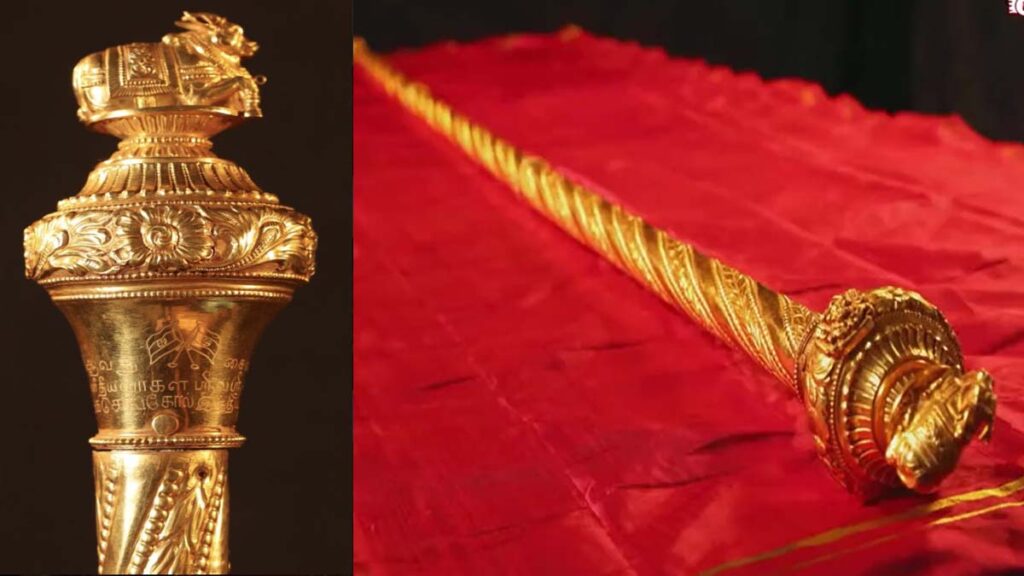Table of Contents
In the newly built Parliament building, Prime Minister Narendra Modi placed a historic sceptre known as “Sengol” next to the Lok Sabha Speaker’s chair. The “sengol” in Parliament will stand for the Rule of Dharma (law). With this sacred sceptre and state-of-the-art technology, the new Parliament will serve as a testament to the Prime Minister’s inclusive vision for India. The “Sengol” is a powerful representation of authority and power, evoking its use in historic South Indian kingdoms.
The Roots and the Backdrop…
The historical sceptre known as “Sengol,” which derives from the Tamil word “semmai,” which means “righteousness,” has attracted attention lately. The ‘Sengol’ is said to have been given to Jawaharlal Nehru by the Adheenam of Tamil Nadu in August 1947 as a symbol of the handover of sovereignty from the British to the Indian people.
By addressing the ‘Sengol’s’ historical context and function, Professor S. Rajavelu, formerly affiliated with the Department of Maritime History and Marine Archaeology at Tamil University, clarifies the ‘Sengol’s’ relevance. He claimed that these sceptres served as representations of justice and sound government for the Tamil monarchs. The ‘Sengol’ custom, which symbolises the peaceful transfer of power from one dynasty to the next, dates back to the Chola era in Tamil Nadu.
The literary masterpiece “Thirukkural” in Tamil spends a whole chapter on the significance of the “Sengol (semmai),” claims Professor S. Rajavelu. This demonstrates the importance of the sceptre in Tamil culture. The symbolism of the “Sengol” is also mentioned in the Tamil epic “Silapathikaram.”
Viceroy Lord Irwin inaugurated the former Parliament building on January 18, 1927, however, there was no mention of Indian culture or “parampara” in the ceremony. However, as the day of India’s independence drew closer, Viceroy Louis Mountbatten questioned Jawaharlal Nehru about how he wanted to symbolise Britain ceding sovereignty to India.
When Nehru looked to C. Rajagopalachari for guidance, the latter suggested that Nehru may follow the old Indic civilisational custom in southern kingdoms, when the high priest of the state gives over the ceremonial sengol to the new king to mark the transfer of power. Rajaji’s notion that the British viceroy giving the sceptre to the new Prime Minister may signify the transfer of power was accepted and adopted.
Rajaji then asked Sri Ambalavana Desika Swamigal, the head of the Shaivite monastery Thiruvaduthurai Adheenam in Tamil Nadu at the time, to take on the task of creating the sceptre. The sceptre was made by a Madras lapidary on the seer’s orders. The Nandi, which stands for strength and truth, was embellished on top, and it was constructed of silver with a gold finish.
The ‘Sengol’ – on the eve of Independence
On August 14, 1947, a delegation headed for Delhi, including the Nadaswaram Vidwan, T N Rajarathinam Pillai, Manickam Odhuvaar, the seer’s emissary, and Sri Kumaraswamy Thambiran.
The priest performed “Kolaru pathigam” from “Thevaram,” devotional hymns created in honour of Lord Shiva over 1,300 years ago, amidst the dulcet melody of the nadaswaram, just before midnight on the eve of Independence. The sceptre was given to Sri Kumaraswamy Thambiran by Lord Mountbatten after the final verses, “Adiyargal vaanil arasalvar aanai namathe,” (“We command that His Humbleness shall rule the heavens”), were recited. He then sprinkled the sceptre with ganga jal (holy water), symbolising the transfer of power, and gave it to Nehru.
The Tryst with Destiny speech is well-known to most Indians, but the historic event of the sengol handover has received less attention in the pages of our magnificent history. This holy sengol was abandoned to utter obscurity in a museum in Allahabad that bore the caption “Golden Walking Stick Gifted to Pt. Jawaharlal Nehru” during the change of power in 1947.
Significance Today
The government’s “Azadi ka Amrit Mahotsav,” which was introduced to commemorate 75 years of independence, has made sure that lesser-known heroes and heroines and untold milestones receive the recognition they merit. While the Madhavpur Mela exhibited harmony between Gujarat in the west and the Mishmi tribes of Arunachal Pradesh in the east, the Kashi Tamil Sangamam explicitly evoked the togetherness between the north and the south. Similar to how the sengol story effectively demonstrates our great nation’s natural civilisational connection and unity from time immemorial.
The Prime Minister has always been a fervent supporter of embracing innovation and technology while being firmly grounded in our rich spiritual and cultural history. With this sacred sceptre and state-of-the-art technology, the new Parliament will serve as a testament to the Prime Minister’s inclusive vision for India.
It is indeed appropriate that our Prime Minister placed this holy sceptre in the Lok Sabha’s Speaker’s Chair, where it belongs. This sengol will always represent the rule of dharma from this place in the temple of our democracy, the fundamental principle by which our wonderful country is governed.
